

Share this story
- @BESTNCorg released a new comprehensive report on the history, structure, and status of teacher pay in North Carolina. Here are the highlights. #nced
- North Carolina’s teacher pay structure is making the profession less attractive for qualified candidates, a new report from @BESTNCorg found. Find out what else is in the report. #nced
|
|
Today, BEST NC released a new comprehensive report on the history, structure, and status of teacher pay in North Carolina.
It is worth a read.
To kick off the conversation I hope this report sparks, I have excerpted the parts of the report I find most interesting and important.
Why does teacher pay matter?
“Research has consistently found that teachers are the single-most important in-school factor for student success, with a high-performing teacher producing three times the achievement growth of a low-performing teacher.”
How do we know how much teachers should be paid?
“As economist Dick Startz wrote, ‘The bottom line on deciding on compensation is whether you’re paying enough to get a sufficiently large supply of sufficiently good employees. In other words, if you think we have more great teachers than we need, you should be okay with lower compensation rates. Contrariwise, if you think we need more great teachers than we have on board then you should want to raise salaries.'”
How much does it cost to raise teacher pay?
“At more than $50 million per 1% pay increase, teacher pay increases are costly and investments must be mindful of the overall cost of education and the sources of funding available to pay for it.”
What’s the historical context for teacher pay?
“Today’s teacher pay schedules are based on a 100-year-old pay model that assumed every teacher had roughly equal skills, and that the mostly-female workforce had few alternative career opportunities as well as a spouse with a higher income to help support a family.”
What are the five major challenges in how teachers are currently paid?
1. Teaching is a mostly female workforce, yet teacher pay has not kept up with increasing opportunities and pay for female, college-educated professionals, nor with pay for other public sector employees.
2. Under the existing salary schedule, teachers must wait far too long before their salaries provide a living wage to support a family, with as many as one-third of North Carolina teachers falling into this gap.
3. The current teacher compensation model does not provide meaningful professional promotions that attract top talent and keep effective educators in the classroom, incentivizing them to take on roles in school administration or leave the profession altogether.
4. Existing pay structures are not designed to fill hard-to-staff subject area positions and schools, leading to persistent, critical vacancies and disparities in student access to effective educators.
5. Starting teacher pay is not competitive with surrounding states, making it difficult to attract top candidates and compete for talent in our region.
What are the numbers to know?
According to the report, there are more than 100,000 teachers serving 1.5 million students in 2,700 schools in 2022-23. Average starting teacher pay is $37,127, and average teacher pay is $57,805.
This chart shows average teacher pay with benefits over a 25-year career:
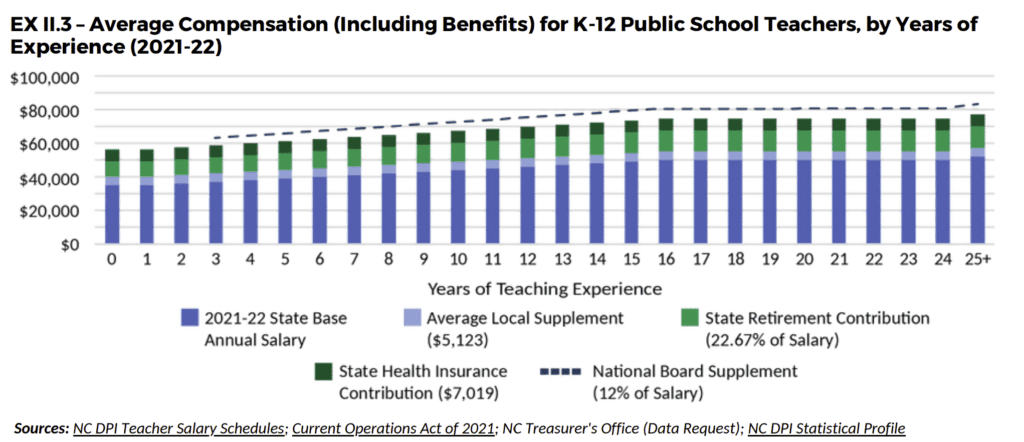

“College-educated female pay has now met and surpassed average teacher pay, making teaching arguably less attractive to both female and male talent pools, particularly for top-tier candidates,” the report found. You can see this in this chart:
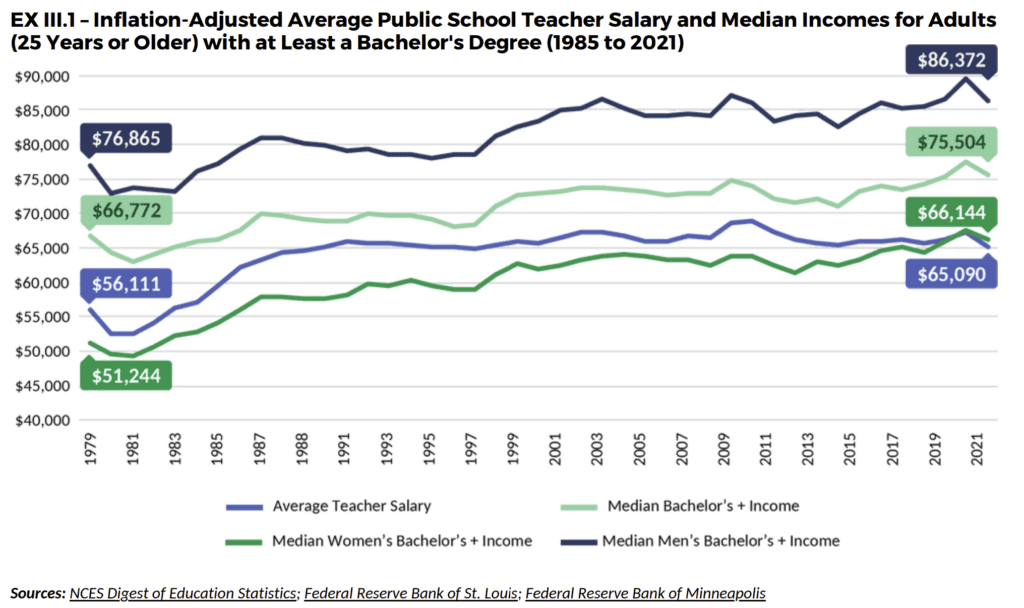

“The state salary schedule should be considered the floor, not the ‘ceiling,’ for teacher pay. Pay increases occur in multiple ways including legislated increases, local salary supplements, and opportunities for additional pay, such as for National Board Certification status and Advanced Teaching Roles.”
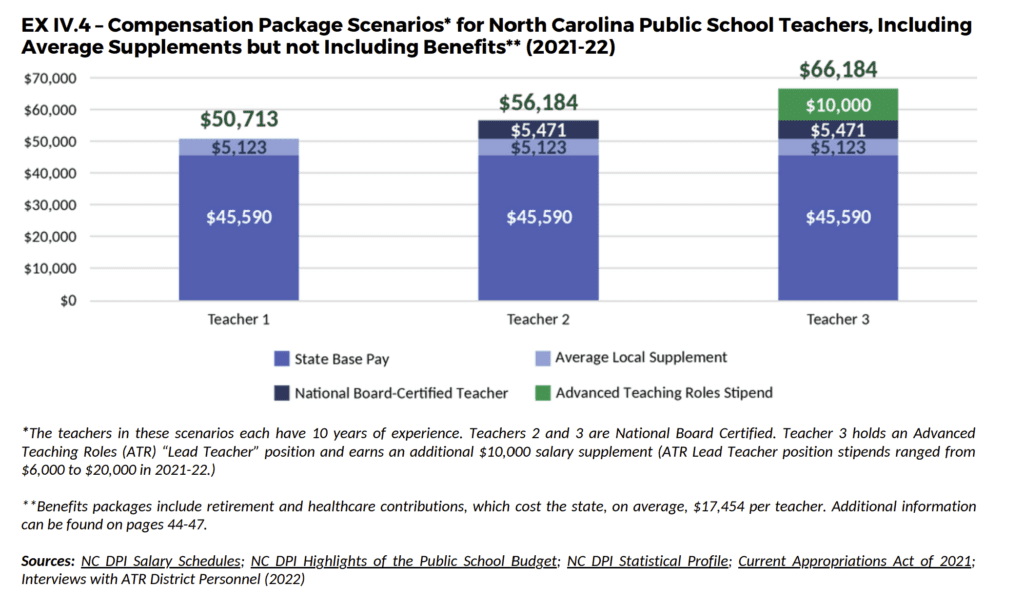

“The Great Recession had a negative impact on teachers’ salaries across the country and, in North Carolina, resulted in five consecutive years of salary freezes from 2009-10 to 2013-14. The outcome was a decline in North Carolina’s average teacher pay ranking and an overall flattening of the teacher salary schedule, especially for teachers early in their career.”
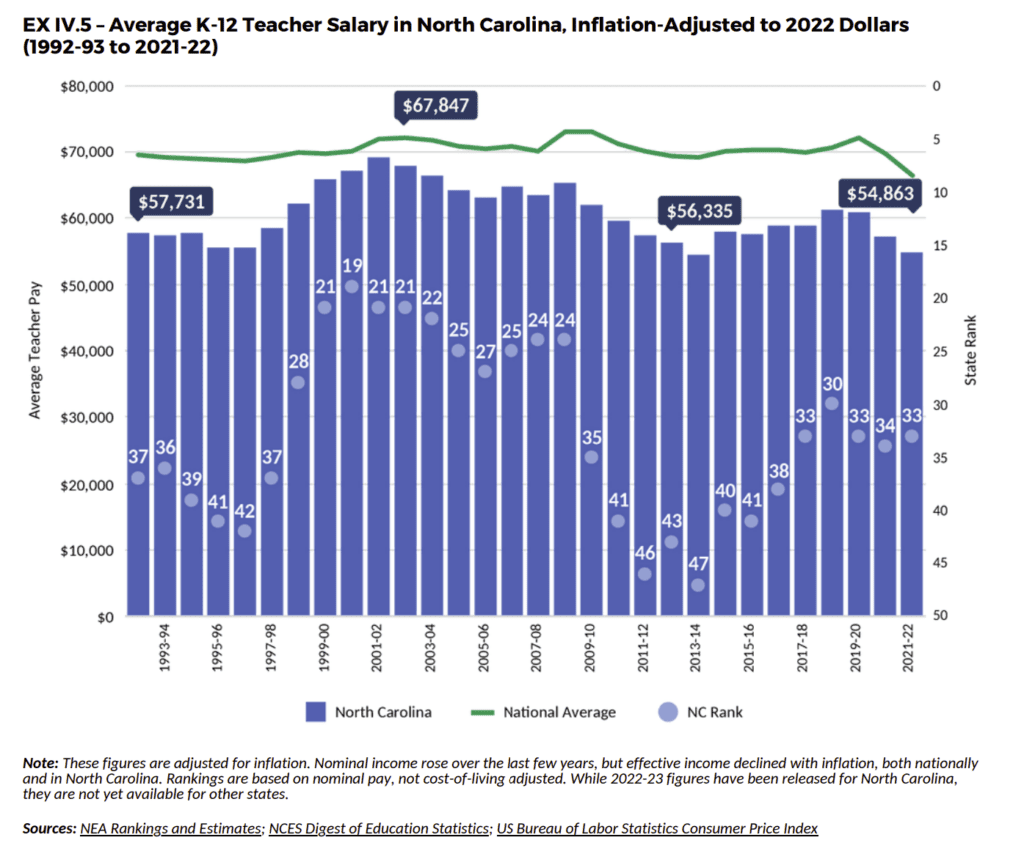

“As in other professional industries, competition for talent supply is regional. In order to compete for talent, particularly beginning teachers as they enter the profession, North Carolina must stay competitive with surrounding states.”
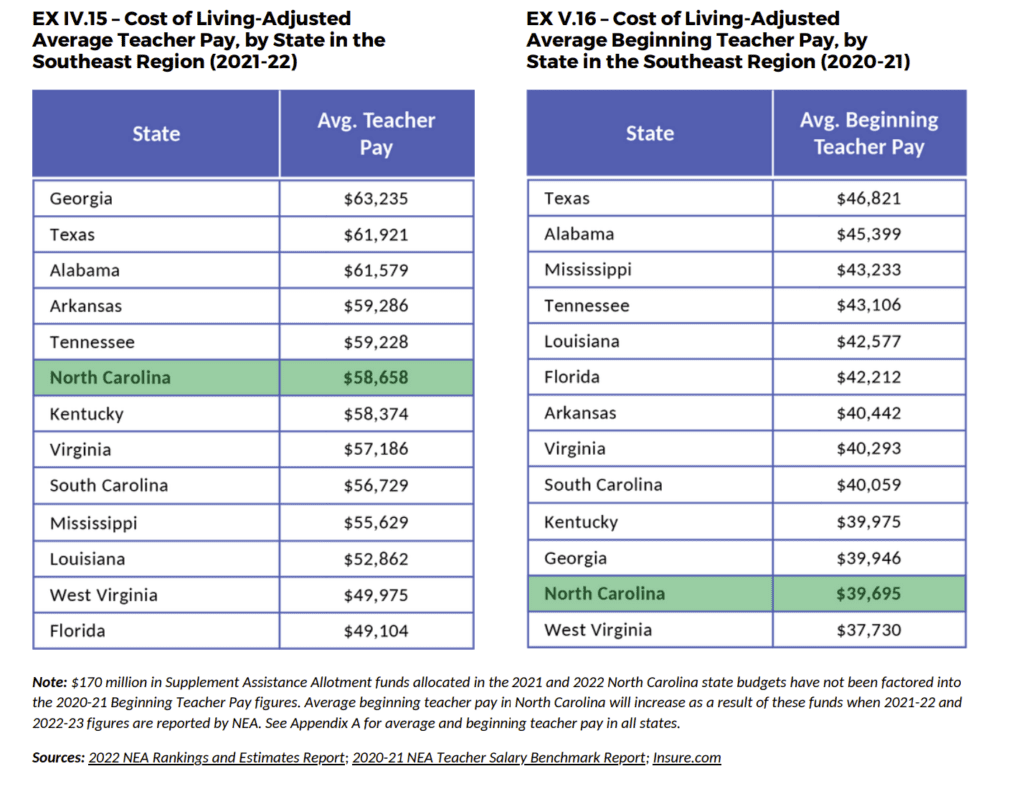

What’s different about how North Carolina funds schools?
In most states, local property taxes are the primary source of funding for education. That’s not how it works in North Carolina, where the state contributes 62% of revenue.


What’s the impact of local salary supplements?
“In 2021-22, the statewide average local supplement was $5,123 and supplements ranged from $8,678 in Charlotte-Mecklenburg Schools and $8,670 in Wake County Public Schools to $0 in four school districts: Caswell County Schools, Clay County Schools, Graham County Schools, and Swain County Schools.”
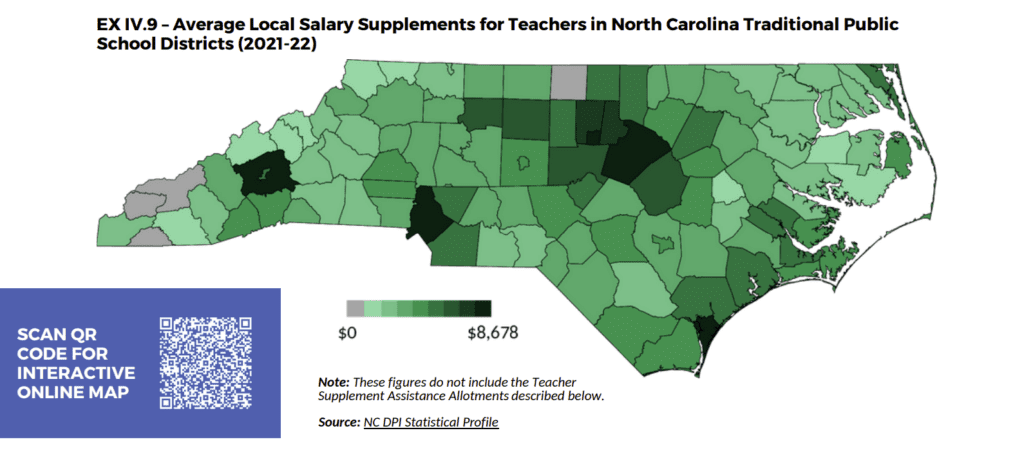

What else impacts teacher salary?
“In an effort to help lower-wealth districts provide more competitive local salary supplements to teachers, the North Carolina General Assembly created the Teacher Supplement Assistance Allotment in 2021 with $100 million in recurring funding. In 2022, an additional $70 million in recurring funds were added for this purpose. In 2021-22, districts qualified for funds if they had less than or equal to $43 billion in taxable property. Under these criteria, all but four school districts (Wake County Public Schools, Durham Public Schools, Guilford County Schools, and Charlotte-Mecklenburg Schools) qualified for funding.”


What is teacher sorting and why does it matter?
“The classroom teacher allotment is by far the largest single state allotment: salary and benefits for instructional personnel represent approximately 58% of total state support for education.”
“The position allotment system is intended to provide equal access to highly qualified teachers for all schools and districts — because the state funds positions rather than dollar amounts, districts can hire teachers without regard to how much the teacher will cost to employ.”
“The reality is, however, that teachers are not evenly distributed across the state, and they can choose to which schools and districts they want to apply. More experienced and qualified teachers are concentrated in more affluent schools and districts, while schools with greater percentages of economically disadvantaged students have applicant pools that are less experienced and have lower qualifications. Researchers call this phenomenon teacher sorting.”
“In school districts where teachers stay longer, on average, and in which the applicant pool is rich with National Board-Certified teachers, the amount of money the district receives, per allotted classroom teaching position, is greater than in districts with less experienced teachers. This results in significant funding inequity that is embedded into North Carolina’s education system.”
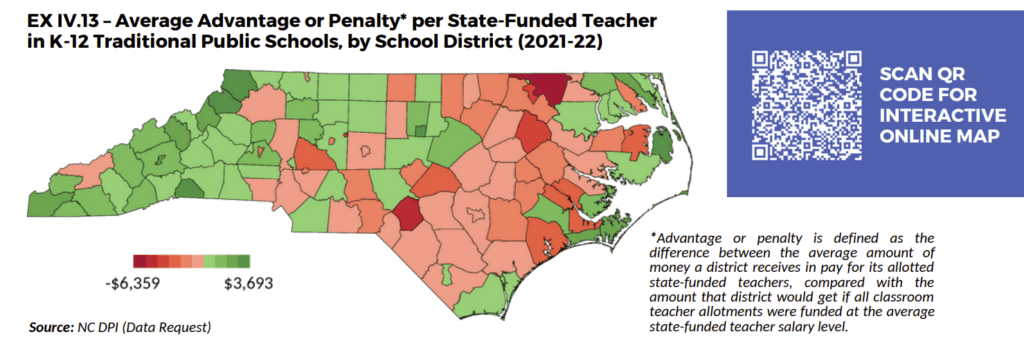

How can North Carolina meaningfully address teacher pay?
The report recommends modern, evidence-informed compensation strategies, including:
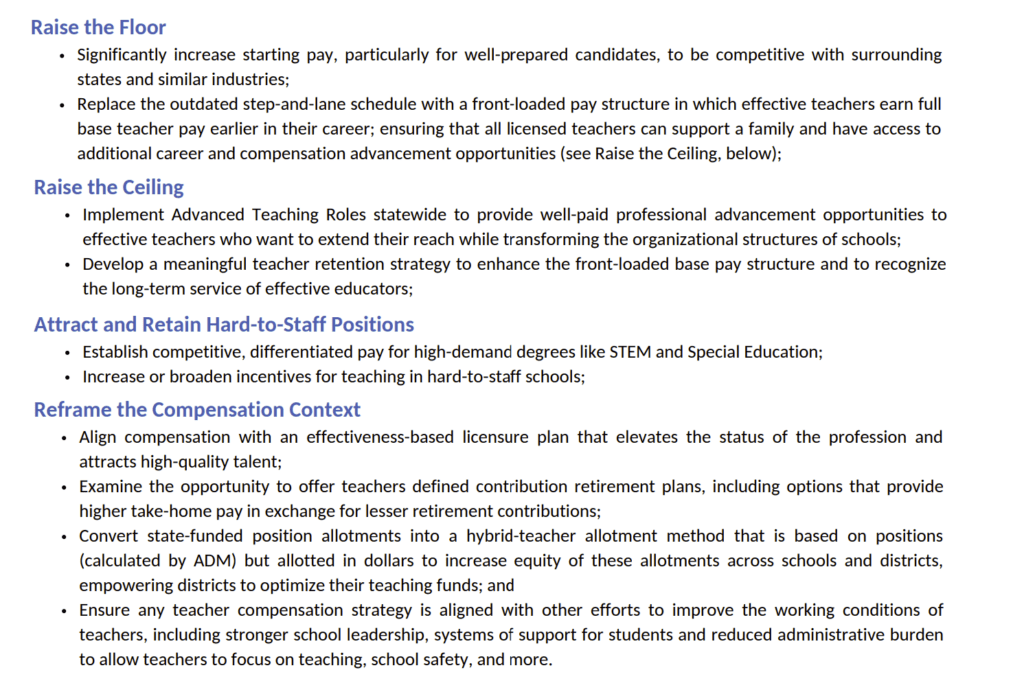

As the report says, “Our state’s economy and the prosperity of our public school graduates depends on access to great educators – every student, every day.”





